UP Board Class 10 Biology Notes For Control And Coordination
Control is the faculty to regulate an activity, start it, slow down it, expedite it, or stop it. Coordination is the orderly working of different parts to smoothly carry out an activity.
- For example, during the eating of food, the nose smells it, saliva moistens the food, teeth masticate it and the tongue tastes it as well as moves it for mastication and swallowing.
- However, if the nose is blocked due to a bad cold, the food will appear bland or tasteless showing the requirement of coordination between smell and taste.
- Major controls and coordination are achieved through movements. Movements or changes in position are of two types-growth movements and nongrowth movements.
- Growth movements mostly occur in plants, for example., sprouting of seed to form seedlings. Animals perform mostly nongrowth movements, for example., running, playing, buffalo chewing cud, and shouting.
- Plants also perform many non-growth movements for example., folding and drooping of leaves in Sensitive Plant on being touched.
- Movements usually occur in response to changes in the external or internal environment. They are carefully controlled and coordinated. For example, while talking to your classmates in the class you whisper. In the playground, you shout at your classmates.
- In multicellular organisms, control and coordination are achieved using specialized tissues and organs. In animals, this is performed by nervous tissue and muscular tissue.
Additional control and coordination are achieved through the endocrine system. In plants, only the endocrine system operates in control and coordination.
control and coordination class 10
UP Board Class 10 Biology Notes For Control And Coordination Animals Nervous System
What is the system to detect information from the environment? What are receptors?
The nervous system is a system of nervous organs, nerves, and a network of electrically conducting neurons that runs throughout the body of the animal for controlling and coordinating body activities. Body activities are performed in response to internal and external stimuli.
- Stimulus is a detectable change in environment, factor, agent, or chemical that brings about a response in the organism.
- The response is the specific reaction of an organism to a specific stimulus.
- Receptors are cellular structures that are capable of receiving specific stimuli and generating impulses to be picked up by sensory or afferent nerves.
- An impulse is an electrical signal that travels along the length of nerve fiber for the passage of information.
- Effectors are muscles, glands, cells, tissues, or organs that respond to a stimulus received through nerve impulses. The message to effectors is sent through motor or efferent nerves.
- Sense and Sense Organ. The faculty by which an organism perceives the change in external or internal environment is called sense, for example., smell, hearing, touch.
- The organ which contains sensory receptors for obtaining information about the environment is called a sense organ, for example., the eye, or ear.
- In humans and higher animals, there is the brain that functions as a super center for the control and coordination of various activities. The basic unit of the nervous system is neurons or nerve cells.
Neuron or Nerve Cell
A neuron or nerve cell is the structural and functional unit of the nervous system. It can receive, conduct, and transmit impulses. Neurons appear like miniature branched trees.
It can reach a length of 90-100 cm. A neuron has three parts body, dendrites, and axon. Dendrites and axons are collectively called neurites.
- Cell Body (Cyton). It is the widest part of neuron which is polygonal with a stellate outline. There is a prominent centrally located nucleus, various cell organelles (except centrosome), and two special structures, Nissl granules and neurofibrils. Nissl granules are ribosomes containing particles. Neurofibrils are cytoskeletal fibrils (microtubules, microfilaments, and neurofilaments).
- Dendrites. They are short, fine, branched, protoplasmic outgrowths of the cell body. Nissl granules and neurofibrils are present. Dendrites pick up sensations and transmit the same to the cell body.
- Axon. It is a long fiber-like process of the cell body that is specialized to carry impulses away from the cell body. It contains neurofibrils but lacks Nissl granules. Axon is branched terminally to form knobbed ends called boutons. They are meant for transmission of impulses to another neuron, cell, gland, muscle, or organ.
Axon is covered by one or two sheaths. The ensheathed axon is known as a nerve fiber. The single or the outer sheath is called neurilemma (= neurolemma).
- It is made up of Schwann cells. When two layers are present, the inner layer is made of lipid or myelin. Such nerve fibers are called myelinated or medullated.
- At intervals, nonmyelinated areas occur. They are called nodes of Ranvier. Myelinated or medullated nerve fibers are more efficient in the transmission of impulses than nonmedullated ones.
” coordination class 10″
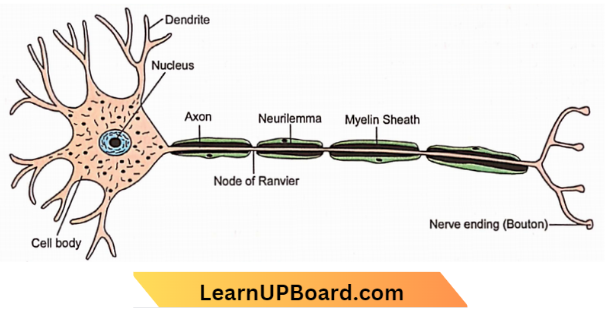
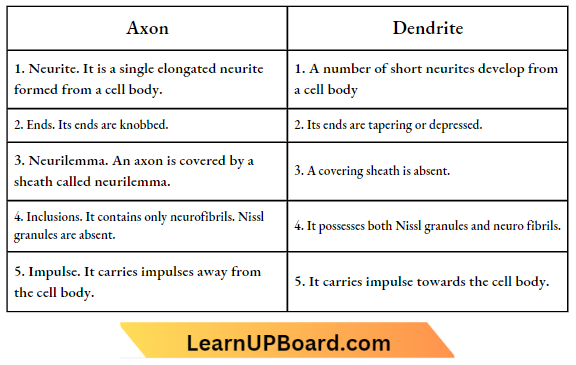
Types Of Neurons
- Depending upon the Impulne enameled motor or Inlerneuron, Scnnory or account lemon picks up Nenmny Impulse iVom lorcplt^i or sense organ and immimilii llm same towards brain or spinal cord.
- Motor or efferent neuron carries a message from the brain or spinal cord to muscle, gland, organ, or other effector.
Nerves
What is a nerve? Name different types of nerves.
- They are elongated thread-like structures of the nervous system which are formed by grouping and regrouping of nerve fibers inside the sheath of connective tissue.
- Connective tissue sheaths keep the nerve fibers insulated from one another. Like neurons, based on their functioning, nerves are of three types -sensory, motor, and mixed. Mixed nerves contain both sensory and motor fibers.
Differences between Sensory and Motor Nerve Fibres
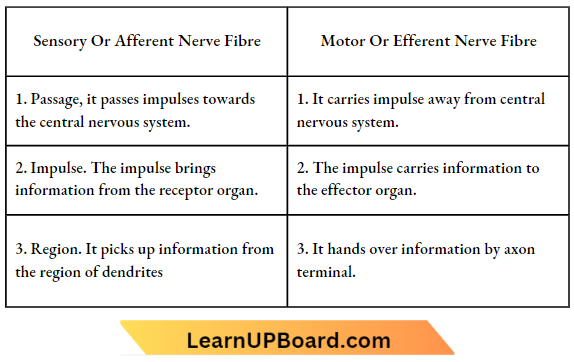
Transmission of Nerve Impulse
Define impulse. Name the chemical that helps in the transmission of impulses.
An impulse is a self-propagated electrical signal that travels along the length of the neuron for the passage of a message. At rest, a neuron is polarized with a positively charged exterior and a negatively charged interior.
- As soon as it receives a stimulus, the neuron region undergoes depolarisation with the outer surface becoming negatively charged and the inner surface becoming positively charged. This happens due to the opening of ion channels causing entry of Na+ ions inside the nerve.
- The depolarized region functions as a local current or stimulus which depolarises the next part of the nerve while itself becoming polarised. The process continues till the impulse reaches the end of the neuron.
- From here impulse jumps to the next neuron, muscle, or other ‘target organ with the help of chemicals (for example.,. acetylcholine) called neurotransmitters.
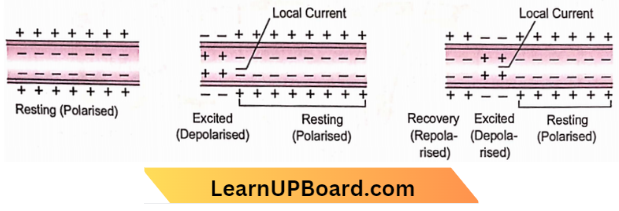
Synapse
It is a narrow communicating junction between two neurons. The axon terminal of one neuron forms a presynaptic Knob. The dendrite tip of the next neuron is expanded but depressed to form postsynaptic depression.
- The narrow space between the two is called the synaptic cleft. The presynaptic knob possessed a number of neurotransmitters containing synaptic vesicles.
- The remembrance of the postsynaptic depression possesses several chemoreceptor sites.
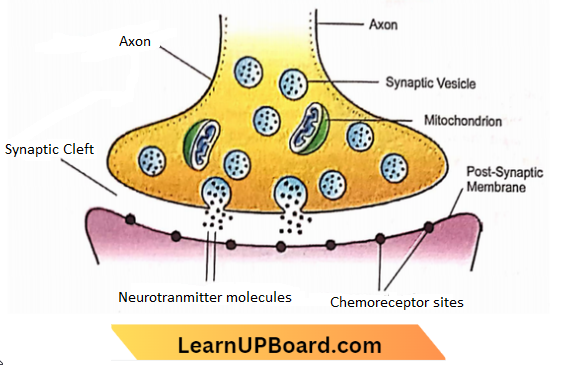
As the impulse reaches the presynaptic knob, it activates the synaptic vesicles. They reach the presynaptic membrane and burst open. Ncurotransmittcr (for example., acetylcholine) is released.
Neurotransmitter molecules come in contact with chemoreceptor sites of the postsynaptic membrane.
chapter 7 science class 10 ncert solutions
The latter becomes depolarized to generate an electric current or impulse. The impulse travels across the synapse only in one direction from the axon terminal to the dendrite tip.
Neuromuscular Junction
What is a neuromuscular junction? Give its function.
It occurs at the junction between the muscle (or some other effector organ) and the axon end of the motor neuron. The axon end bears a motor end plate of knobbed branches.
- A knob or bouton of the motor end plate comes in near contact with depression called a sole plate on the surface of the muscle fiber. As the motor impulse reaches the synaptic knob, it activates the synaptic vesicles.
- They come to the surface and burst releasing neurotransmitters (for example., acetylcholine). The neurotransmitter coming in contact with the sole plate receptors brings about excitation that causes the muscle to contract.
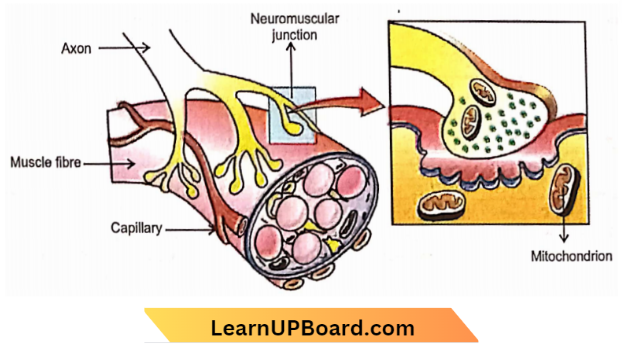
UP Board Class 10 Biology Notes For Control And Coordination Activity 2.1
Taste Vs Smell
Put some sugar in your mouth. It tastes sweet. Rinse mouth with water. Block your nose with your thumb and index finger. Put some sugar again in your mouth. There is very little sweetness indicating that our taste is largely governed by smell.
Nerve Actions
There are three types of nerve actions, involuntary and reflex, Voluntary nerve action is under the control or command of the brain, for example., talking, and writing.
what do you mean by control and coordination
- Involuntary nerve action operates without the command of the brain as per the requirement of sensation generated in internal organs, for example., peristalsis.
- Reflex action is nerve-mediated automatic mechanical and immediate response to a stimulus for protection and functional efficiency, eg., closing of eyes when strong light is flashed over them, pulling of hand from a hot surface before the brain feels the pain.
UP Board Class 10 Biology Notes For Control And Coordination Long Answer Type Questions
Question 2. Mention the part of the brain involved in the following:
- Walking in a straight line.
- Picking up a pencil.
- Blood pressure.
- A question is asked by the teacher in the class.
- Change in size of the pupil in response to the intensity of light.
Answer:
- Walking in a straight line. Cerebellum.
- Picking up a pencil. Cerebrum and cerebellum.
- Blood Pressure. Medulla oblongata.
- The question being asked by the teacher. Temporal lobe and frontal lobe of the cerebrum.
- Changing pupil. Superior corpora quadrigemina of midbrain.
ch 7 science class 10 ncert solutions
Question 5.
- Define nerve impulse. Name the structure that helps to conduct a nerve impulse
- Towards cell body
- Away from the cell body.
- Why have organisms adapted to use electrical impulses to transmit messages? State two limitations of the use of electrical impulses.
Answer:
- Nerve Impulse. It is a progressive electrochemical wave that develops in response to stimulus and travels along a nerve fiber to stimulate or inhibit the action of another nerve, muscle, or gland.
- Dendrite
- Axon.
- Electrochemical impulses are very fast. There is no chance of spillover or after-effects. This allows the animal body to use the same nerve time and again.
Impulse Limitations.
- Electrochemical impulse is unidirectional.
- It is short-acting, also in the presence of stimulus only,
- It does not reach every cell of the body,
- After the generation and transmission of an electrical impulse, the nerve cell will take some time to receive and transmit a fresh electrochemical impulse.
